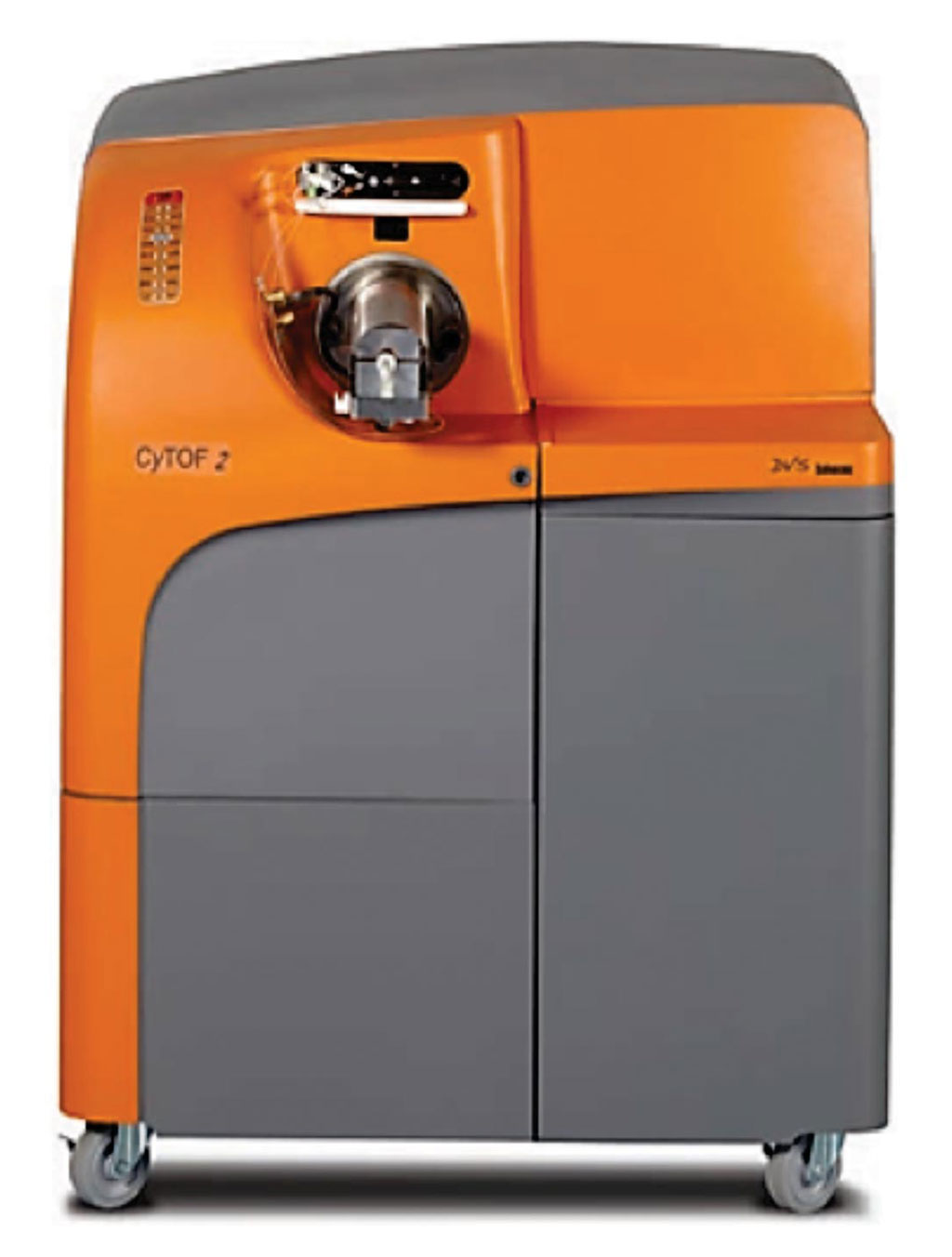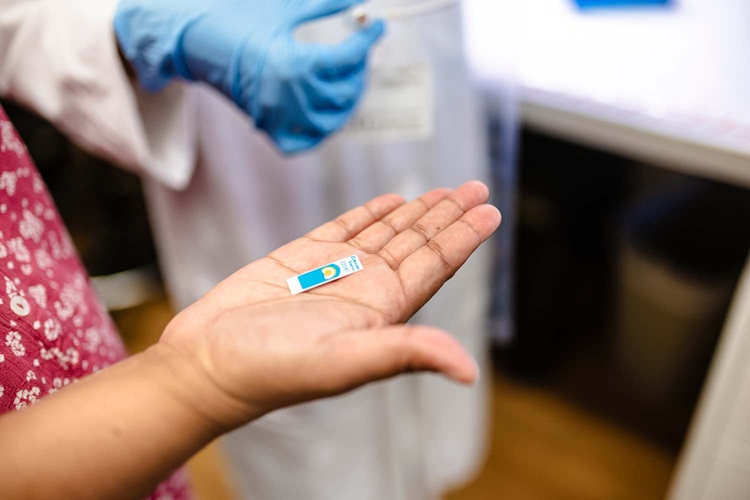Adaptive Immune Cells in Ulcerative Colitis Revealed by Single-Cell Analyses
|
By LabMedica International staff writers Posted on 01 Sep 2020 |

Image: Mass cytometry by time of flight uses CyTOF technology to enable deep profiling of translational and clinical samples across a range of cell surface and intracellular markers (Photo courtesy of University of Virginia).
Inflammatory bowel disease encompasses a spectrum of complex intestinal disorders characterized by dysregulated innate and adaptive immune responses to gut microbiota in genetically susceptible hosts.
Inflammatory bowel disease (IBD) is typically categorized as Crohn’s disease or ulcerative colitis (UC) on the basis of anatomic, clinical, and histopathologic criteria. Dysregulated human gut B and T lymphocytes contribute to the immunopathogenesis of UC, a type of IBD characterized by mucosal damage in the colon.
A large team of medical scientists led by those at the University of California at San Diego (La Jolla, CA, USA) obtained intestinal biopsies and peripheral blood from patients undergoing colonoscopy at their facilities. Cells were recovered, washed, filtered, and used for mass cytometry by time of flight (CyTOF, Fluidigm, South San Francisco, CA, USA) or labeled with anti-human CD45 for sorting. CD45+ immune cells were sorted on a FACSAria II (BD Biosciences, San Jose, CA, USA). Intestinal biopsies were mechanically dissociated, then placed into a digestion mixture, filtered, and stained with anti-human CD45. CD45+ immune cells were sorted on a FACSAria II. About 20,000 sorted CD45+ cells were loaded and partitioned into Gel Bead In-Emulsions. Single-cell RNA (scRNA) libraries were sequenced on a HiSeq 4000 (Illumina, San Jose, CA, USA).
The investigators found a suite of ulcerative colitis-related immune cell shifts and clonal relationships, from clonal B cell receptor clonotype clusters and an uptick in plasma cells expressing immunoglobulin G1 to a rise in ZEB2 transcription factor-expressing regulatory T cells in colon tissue. The resulting single-cell sequencing resource revealed heterogeneity among tissue-resident memory T cells (TRM) in UC, including expansion of an inflammatory CD8+ TRM subset expressing the Eomesodermin transcription factor.
The team also flagged informative transcriptional features in CD8+ tissue-resident memory T cells typically tasked with buffeting bacterial infections, defining a handful of transcriptionally distinct clusters of the cells in colon tissue that differed from healthy tissue to tissue affected by ulcerative colitis, including a cluster with more inflamed versions of the CD8+ tissue-resident T cells.
The authors concluded that their study identified alterations in immune cell types and clonal relationships that occur in the context of disease, including plasma cells, Treg cells, γδ T cells, and CD8+ TRM cells, and will enable other investigators to identify additional UC-associated changes in a cell type– and tissue-specific manner for further study. The study was published on August 21, 2020 in the journal Science Immunology.
Related links:
University of California at San Diego
Fluidigm
BD Biosciences
Illumina
Inflammatory bowel disease (IBD) is typically categorized as Crohn’s disease or ulcerative colitis (UC) on the basis of anatomic, clinical, and histopathologic criteria. Dysregulated human gut B and T lymphocytes contribute to the immunopathogenesis of UC, a type of IBD characterized by mucosal damage in the colon.
A large team of medical scientists led by those at the University of California at San Diego (La Jolla, CA, USA) obtained intestinal biopsies and peripheral blood from patients undergoing colonoscopy at their facilities. Cells were recovered, washed, filtered, and used for mass cytometry by time of flight (CyTOF, Fluidigm, South San Francisco, CA, USA) or labeled with anti-human CD45 for sorting. CD45+ immune cells were sorted on a FACSAria II (BD Biosciences, San Jose, CA, USA). Intestinal biopsies were mechanically dissociated, then placed into a digestion mixture, filtered, and stained with anti-human CD45. CD45+ immune cells were sorted on a FACSAria II. About 20,000 sorted CD45+ cells were loaded and partitioned into Gel Bead In-Emulsions. Single-cell RNA (scRNA) libraries were sequenced on a HiSeq 4000 (Illumina, San Jose, CA, USA).
The investigators found a suite of ulcerative colitis-related immune cell shifts and clonal relationships, from clonal B cell receptor clonotype clusters and an uptick in plasma cells expressing immunoglobulin G1 to a rise in ZEB2 transcription factor-expressing regulatory T cells in colon tissue. The resulting single-cell sequencing resource revealed heterogeneity among tissue-resident memory T cells (TRM) in UC, including expansion of an inflammatory CD8+ TRM subset expressing the Eomesodermin transcription factor.
The team also flagged informative transcriptional features in CD8+ tissue-resident memory T cells typically tasked with buffeting bacterial infections, defining a handful of transcriptionally distinct clusters of the cells in colon tissue that differed from healthy tissue to tissue affected by ulcerative colitis, including a cluster with more inflamed versions of the CD8+ tissue-resident T cells.
The authors concluded that their study identified alterations in immune cell types and clonal relationships that occur in the context of disease, including plasma cells, Treg cells, γδ T cells, and CD8+ TRM cells, and will enable other investigators to identify additional UC-associated changes in a cell type– and tissue-specific manner for further study. The study was published on August 21, 2020 in the journal Science Immunology.
Related links:
University of California at San Diego
Fluidigm
BD Biosciences
Illumina
Latest Pathology News
- Rapid Low-Cost Tests Can Prevent Child Deaths from Contaminated Medicinal Syrups
- Tumor Signals in Saliva and Blood Enable Non-Invasive Monitoring of Head and Neck Cancer
- Common Health Issues Can Influence New Blood Tests for Alzheimer’s Disease
- Blood Test Formula Identifies Chronic Liver Disease Patients with Higher Cancer Risk
- Tunable Cell-Sorting Device Holds Potential for Multiple Biomedical Applications
- AI Tool Outperforms Doctors in Spotting Blood Cell Abnormalities
- AI Tool Rapidly Analyzes Complex Cancer Images for Personalized Treatment
- Diagnostic Technology Performs Rapid Biofluid Analysis Using Single Droplet
- Novel Technology Tracks Hidden Cancer Cells Faster
- AI Tool Improves Breast Cancer Detection
- AI Tool Predicts Treatment Success in Rectal Cancer Patients
- Blood Test and Sputum Analysis Predict Acute COPD Exacerbation
- AI Tool to Transform Skin Cancer Detection with Near-Perfect Accuracy
- Unique Immune Signatures Distinguish Rare Autoimmune Condition from Multiple Sclerosis
- Simple Optical Microscopy Method Reveals Hidden Structures in Remarkable Detail
- Hydrogel-Based Technology Isolates Extracellular Vesicles for Early Disease Diagnosis
Channels
Clinical Chemistry
view channel
POC Breath Diagnostic System to Detect Pneumonia-Causing Pathogens
Pseudomonas aeruginosa is a major cause of hospital-acquired and ventilator-associated pneumonia, particularly in lung transplant recipients and patients with structural lung disease. Its ability to form... Read more
Online Tool Detects Drug Exposure Directly from Patient Samples
Doctors often rely on patient interviews and medical records to determine what medications a person has taken, but this information is frequently incomplete. People may forget drugs they used, take over-the-counter... Read moreMolecular Diagnostics
view channel
STI Molecular Test Delivers Rapid POC Results for Treatment Guidance
An affordable, rapid molecular diagnostic for sexually transmitted infections (STIs) has the potential to be globally relevant, particularly in resource-limited settings where rapid, point-of-care results... Read more
Blood Biomarker Improves Early Brain Injury Prognosis After Cardiac Arrest
After a cardiac arrest, many patients remain unconscious for days, leaving doctors and families facing uncertainty about whether meaningful recovery is possible. Current tools to assess brain damage, including... Read more
Biomarkers Could Identify Patients at High Risk of Severe AKI After Major Surgery
Acute kidney injury is one of the most common and dangerous complications after major surgery, particularly among patients in intensive care. Even mild impairment of kidney function can lead to long-term... Read more
CLIA Test Identifies Head and Neck Cancer Recurrence from Post-Surgical Lymphatic Fluid
While the lymphatic system’s critical role in metastasis has long been recognized, routine access to patient lymph has been elusive. Now, a non-invasive process can access lymph through the collection... Read moreHematology
view channel
MRD Tests Could Predict Survival in Leukemia Patients
Acute myeloid leukemia is an aggressive blood cancer that disrupts normal blood cell production and often relapses even after intensive treatment. Clinicians currently lack early, reliable markers to predict... Read more
Platelet Activity Blood Test in Middle Age Could Identify Early Alzheimer’s Risk
Early detection of Alzheimer’s disease remains one of the biggest unmet needs in neurology, particularly because the biological changes underlying the disorder begin decades before memory symptoms appear.... Read more
Microvesicles Measurement Could Detect Vascular Injury in Sickle Cell Disease Patients
Assessing disease severity in sickle cell disease (SCD) remains challenging, especially when trying to predict hemolysis, vascular injury, and risk of complications such as vaso-occlusive crises.... Read more
ADLM’s New Coagulation Testing Guidance to Improve Care for Patients on Blood Thinners
Direct oral anticoagulants (DOACs) are one of the most common types of blood thinners. Patients take them to prevent a host of complications that could arise from blood clotting, including stroke, deep... Read moreMicrobiology
view channel
Breakthroughs in Microbial Analysis to Enhance Disease Prediction
Microorganisms shape human health, ecosystems, and the planet’s climate, yet identifying them and understanding how they are related remains a major scientific challenge. Even with modern DNA sequencing,... Read more
Blood-Based Diagnostic Method Could Identify Pediatric LRTIs
Lower-respiratory tract infections (LRTIs) are a leading cause of illness and death worldwide, and pneumonia is the leading infectious cause of death in children under five, claiming the lives of over... Read morePathology
view channel
Rapid Low-Cost Tests Can Prevent Child Deaths from Contaminated Medicinal Syrups
Medicinal syrups contaminated with toxic chemicals have caused the deaths of hundreds of children worldwide, exposing a critical gap in how these products are tested before reaching patients.... Read more
Tumor Signals in Saliva and Blood Enable Non-Invasive Monitoring of Head and Neck Cancer
Head and neck cancers are among the most aggressive malignancies worldwide, with nearly 900,000 new cases diagnosed each year. Monitoring these cancers for recurrence or relapse typically relies on tissue... Read more
Common Health Issues Can Influence New Blood Tests for Alzheimer’s Disease
Blood-based tests for Alzheimer’s disease are transforming diagnosis by offering a simpler alternative to spinal taps and brain imaging. However, many people evaluated at memory clinics also live with... Read more
Blood Test Formula Identifies Chronic Liver Disease Patients with Higher Cancer Risk
Chronic liver disease affects millions worldwide and can progress silently to hepatocellular carcinoma (HCC), one of the deadliest cancers globally. While surveillance guidelines exist for patients with... Read moreTechnology
view channel
Machine Learning Models Diagnose ALS Earlier Through Blood Biomarkers
Amyotrophic lateral sclerosis (ALS) is a rapidly progressive neurodegenerative disease that is notoriously difficult to diagnose in its early stages. Early symptoms often overlap with other neurological... Read more
Artificial Intelligence Model Could Accelerate Rare Disease Diagnosis
Identifying which genetic variants actually cause disease remains one of the biggest challenges in genomic medicine. Each person carries tens of thousands of DNA changes, yet only a few meaningfully alter... Read moreIndustry
view channel
BD and Penn Institute Collaborate to Advance Immunotherapy through Flow Cytometry
BD (Becton, Dickinson and Company, Franklin Lakes, NJ, USA) has entered into a strategic collaboration with the Institute for Immunology and Immune Health (I3H, Philadelphia, PA, USA) at the University... Read more









 assay.jpg)








